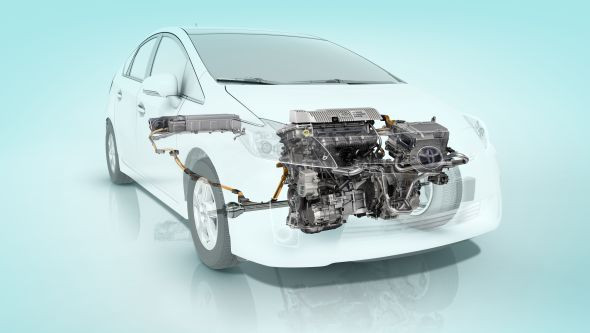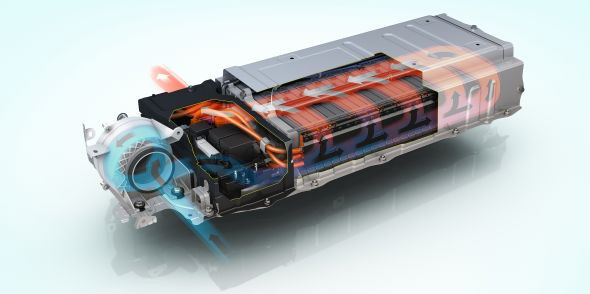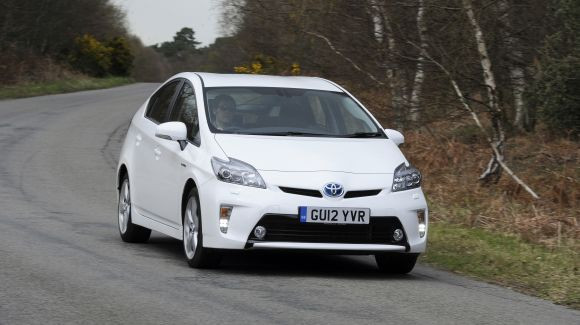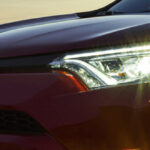How Does A Hybrid Toyota Work? Hybrid Toyotas, available at millertoyota.net, seamlessly blend gasoline engines and electric motors for superior fuel efficiency. Discover how these vehicles optimize performance and minimize emissions, offering Boise drivers an eco-friendly and cost-effective driving experience. Explore the innovative synergy of Toyota’s hybrid technology and learn about regenerative braking and battery efficiency to enhance your understanding of hybrid vehicle operation and maximize fuel savings in Boise, Idaho.
1. What Exactly is a Hybrid Vehicle?
A hybrid vehicle is defined as a car that utilizes two or more distinct power sources to propel it. Typically, these power sources consist of an internal combustion engine (ICE) and one or more electric motors, working in tandem to optimize efficiency and performance.
Hybrids come in a few different configurations:
- Full Hybrids: Like the Toyota Prius, these can run on electric power alone, gasoline power alone, or a combination of both.
- Mild Hybrids: These use an electric motor to assist the gasoline engine, but cannot run on electric power alone.
- Plug-in Hybrids (PHEVs): These have a larger battery pack than regular hybrids and can be plugged in to charge, offering a longer electric driving range.
Toyota has been at the forefront of hybrid technology since the introduction of the Prius in 1997. According to Toyota’s official website, their hybrid system, also known as Hybrid Synergy Drive, is designed to maximize fuel efficiency and reduce emissions.
2. How Does Toyota’s Hybrid System Work?
Toyota’s Hybrid Synergy Drive is the most popular hybrid system in the world, with over 15 million units sold since its debut. The system consists of six key components, working seamlessly together:
- Petrol Engine: A specially designed engine, often using the Atkinson cycle for increased efficiency.
- Electric Motor: Provides supplemental power and allows for electric-only driving at low speeds.
- Electric Generator: Charges the hybrid battery and assists in starting the engine.
- Power Control Unit (PCU): Manages the flow of power between the engine, motor, and battery.
- Hybrid Battery: Stores electrical energy for use by the electric motor.
- Power Split Device: An innovative gearbox that smoothly distributes power from the engine, motor, and generator.
The system is designed to intelligently switch between electric power, gasoline power, or a combination of both, depending on driving conditions. As stated on Toyota’s official website, “Our hybrid system intelligently controls the power coming from both sources and tells the car how to combine them for the greatest efficiency and performance.”
 Toyota Hybrid Synergy Drive Components
Toyota Hybrid Synergy Drive Components
3. What are the Benefits of Toyota’s Hybrid Technology?
Toyota’s hybrid technology offers a multitude of benefits for drivers and the environment, including:
- Enhanced Fuel Efficiency: Hybrid vehicles consume less fuel compared to traditional gasoline-powered cars, resulting in substantial savings at the pump. According to fueleconomy.gov, hybrid vehicles generally offer 20-30% better fuel economy than their non-hybrid counterparts.
- Reduced Emissions: By utilizing electric power, hybrid vehicles produce lower emissions, contributing to cleaner air and a reduced carbon footprint. The Union of Concerned Scientists notes that hybrid vehicles can reduce greenhouse gas emissions by 30-50% compared to conventional vehicles.
- Regenerative Braking: This innovative system captures energy during braking and converts it into electricity, which is then stored in the battery. This not only improves fuel efficiency but also reduces wear and tear on the brakes.
- Smooth and Quiet Ride: The electric motor provides instant torque, resulting in smooth acceleration and a quiet driving experience.
These benefits make Toyota’s hybrid vehicles an attractive option for environmentally conscious drivers in Boise, Idaho, looking to reduce their carbon footprint and save money on fuel.
4. How Does Regenerative Braking Work in a Toyota Hybrid?
Regenerative braking is a key component of Toyota’s hybrid system, contributing significantly to its fuel efficiency. When you apply the brakes or lift your foot off the accelerator, the electric motor acts as a generator, capturing the kinetic energy of the vehicle and converting it into electricity.
This electricity is then stored in the hybrid battery, ready to be used later to power the electric motor. This process not only recharges the battery but also helps to slow down the vehicle, reducing the load on the conventional brakes.
According to a study by the National Renewable Energy Laboratory, regenerative braking can recover up to 70% of the energy normally lost during braking in urban driving conditions.
 Toyota Hybrid Regenerative Braking System
Toyota Hybrid Regenerative Braking System
5. How are the Batteries Charged in a Toyota Hybrid?
Toyota’s hybrid system employs two primary methods for charging the hybrid battery:
- Engine-Driven Generator: As previously mentioned, the petrol engine drives a generator, which in turn charges the battery. This ensures that the battery is always topped up, even during highway driving.
- Regenerative Braking: Every time you brake or decelerate, the regenerative braking system captures energy and converts it into electricity, which is then stored in the battery. This is particularly effective in stop-and-go traffic, where frequent braking allows for significant energy recovery.
Unlike plug-in hybrid vehicles, Toyota hybrids do not need to be plugged into an external power source to charge the battery. The hybrid system manages the battery charge automatically, ensuring optimal performance and efficiency.
6. How Long Do Toyota Hybrid Batteries Last?
Toyota hybrid batteries are built to last, with a lifespan that often exceeds the expectations of many drivers. Toyota’s standard battery warranty is five years or 100,000 miles, and can be extended up to 15 years with no limit on total mileage. As stated on Toyota’s website, “The batteries in Toyota’s hybrid vehicles are efficient, corrosion-resistant units designed to last.”
Furthermore, Toyota is committed to recycling hybrid batteries, with a recovery rate of over 90%. These batteries can be remanufactured to make new batteries or repurposed into other forms of stationary energy storage.
According to a report by the Idaho National Laboratory, the vast majority of hybrid batteries last for the life of the vehicle, with only a small percentage needing replacement.
7. Is the Engine in a Toyota Hybrid Different from a Regular Car?
Yes, the internal combustion engine in a Toyota hybrid is often different from those found in conventional cars. Toyota often employs the Atkinson cycle engine, which is designed for increased efficiency.
The Atkinson cycle is a modified version of the traditional Otto cycle, which is used in most gasoline engines. The Atkinson cycle is designed to reduce pumping losses and improve thermal efficiency, resulting in better fuel economy.
According to a study by the Society of Automotive Engineers, Atkinson cycle engines can improve fuel efficiency by up to 10% compared to traditional Otto cycle engines.
 Toyota Prius Engine Bay
Toyota Prius Engine Bay
8. Do I Need to Drive Differently to Maximize Fuel Efficiency in a Toyota Hybrid?
While Toyota’s hybrid system is fully automatic and optimizes fuel efficiency for each driver, there are a few driving techniques that can further enhance your fuel economy:
- Gentle Acceleration and Braking: Avoid aggressive acceleration and braking, as this wastes energy. Smooth and gradual inputs will help the hybrid system operate more efficiently.
- Anticipate Traffic: By anticipating traffic conditions and planning your driving accordingly, you can minimize unnecessary braking and acceleration.
- Use Cruise Control: On the highway, cruise control can help maintain a consistent speed, which can improve fuel economy.
- Take Advantage of EV Mode: In certain conditions, such as low-speed driving or stop-and-go traffic, the hybrid system may switch to electric-only mode. Take advantage of this by driving smoothly and avoiding sudden acceleration.
By adopting these driving techniques, you can maximize the fuel efficiency of your Toyota hybrid and save even more money at the pump.
9. What Toyota Hybrid Models are Available at Miller Toyota in Boise?
Miller Toyota in Boise offers a wide selection of Toyota hybrid models to suit various needs and preferences. Some popular options include:
- Toyota Prius: The iconic hybrid that started it all, offering exceptional fuel economy and a spacious interior.
- Toyota Corolla Hybrid: A compact sedan that combines hybrid efficiency with the Corolla’s reputation for reliability and affordability.
- Toyota Camry Hybrid: A mid-size sedan that offers a comfortable ride, advanced technology, and impressive fuel economy.
- Toyota RAV4 Hybrid: A versatile SUV that combines hybrid efficiency with the RAV4’s spaciousness and all-weather capability.
- Toyota Highlander Hybrid: A three-row SUV that offers ample seating, a luxurious interior, and excellent fuel economy for its size.
Visit millertoyota.net to browse the latest inventory of Toyota hybrid vehicles and schedule a test drive.
10. Why Choose Miller Toyota in Boise for Your Hybrid Vehicle Needs?
Miller Toyota is committed to providing exceptional service and expertise to hybrid vehicle shoppers in Boise, Idaho. Here are a few reasons to choose Miller Toyota:
- Extensive Hybrid Inventory: Miller Toyota offers a wide selection of Toyota hybrid models, ensuring that you can find the perfect vehicle to fit your needs and budget.
- Knowledgeable Staff: The sales and service staff at Miller Toyota are trained to provide expert advice and support for hybrid vehicles.
- Competitive Pricing: Miller Toyota offers competitive pricing on all of its hybrid vehicles, ensuring that you get the best possible deal.
- Exceptional Service: The service department at Miller Toyota is equipped to handle all of your hybrid vehicle maintenance and repair needs.
- Community Involvement: Miller Toyota is actively involved in the Boise community, supporting local charities and organizations.
Visit Miller Toyota today at 208 N Maple Grove Rd, Boise, ID 83704, United States, call +1 (208) 376-8888, or visit millertoyota.net to experience the Miller Toyota difference.
11. Understanding Toyota Hybrid System Generations
Toyota’s Hybrid Synergy Drive has evolved through several generations, each bringing improvements in efficiency, performance, and packaging. Understanding these generations can help you appreciate the advancements in Toyota’s hybrid technology:
| Generation | Key Features | Example Models |
|---|---|---|
| 1st | Introduction of Hybrid Synergy Drive, nickel-metal hydride (NiMH) battery | 1997-2003 Prius |
| 2nd | Improved efficiency, smaller and lighter components | 2004-2009 Prius, 2006-2011 Camry Hybrid |
| 3rd | Further efficiency gains, enhanced EV mode capability | 2010-2015 Prius, 2012-2017 Prius v |
| 4th | Increased thermal efficiency, lithium-ion battery options, improved driving dynamics | 2016-Present Prius, 2018-Present Camry Hybrid |
Each generation of Toyota’s hybrid system represents a step forward in technology, delivering enhanced fuel efficiency, reduced emissions, and improved driving experience.
12. Debunking Common Myths About Hybrid Vehicles
Despite their increasing popularity, hybrid vehicles are still subject to several misconceptions. Let’s debunk some common myths:
- Myth: Hybrid batteries are expensive to replace. While hybrid batteries can be costly, they are designed to last for the life of the vehicle. Additionally, Toyota offers extended warranties on its hybrid batteries, providing peace of mind.
- Myth: Hybrid vehicles are slow and underpowered. Modern hybrid vehicles offer ample power and acceleration, thanks to the combined output of the gasoline engine and electric motor.
- Myth: Hybrid vehicles require special maintenance. Hybrid vehicles generally require the same maintenance as conventional cars, with some components, like brake pads, lasting longer due to regenerative braking.
- Myth: Hybrid vehicles are not suitable for long trips. Hybrid vehicles are perfectly capable of handling long trips, offering excellent fuel economy and a comfortable ride.
By debunking these myths, we can help more drivers understand the true benefits of Toyota’s hybrid technology.
13. The Future of Toyota Hybrid Technology
Toyota is committed to continuing its leadership in hybrid technology, with plans to further improve the efficiency, performance, and affordability of its hybrid vehicles. Some future developments may include:
- Next-Generation Battery Technology: Toyota is investing heavily in the development of next-generation battery technology, such as solid-state batteries, which promise higher energy density, faster charging times, and improved safety.
- Enhanced Hybrid Systems: Toyota is working on further refining its Hybrid Synergy Drive, with the goal of achieving even greater fuel efficiency and reduced emissions.
- Expanded Hybrid Lineup: Toyota plans to expand its hybrid lineup, offering hybrid versions of more of its popular models.
As Toyota continues to innovate in the field of hybrid technology, drivers in Boise, Idaho, can expect even more efficient, powerful, and environmentally friendly vehicles in the years to come.
14. How Can I Schedule a Test Drive of a Toyota Hybrid at Miller Toyota?
Scheduling a test drive of a Toyota hybrid at Miller Toyota is easy. Here are a few options:
- Visit millertoyota.net: Browse the online inventory and select the hybrid model you’re interested in. Click the “Schedule a Test Drive” button and fill out the online form.
- Call Miller Toyota: Call the dealership at +1 (208) 376-8888 and speak with a sales representative to schedule a test drive.
- Visit the Dealership: Stop by Miller Toyota at 208 N Maple Grove Rd, Boise, ID 83704, United States, and speak with a sales representative in person.
A test drive is the best way to experience the benefits of Toyota’s hybrid technology firsthand.
15. What Financing and Leasing Options are Available for Toyota Hybrids at Miller Toyota?
Miller Toyota offers a variety of financing and leasing options to help you get behind the wheel of a Toyota hybrid:
- Financing: Miller Toyota works with a network of lenders to offer competitive interest rates and flexible loan terms.
- Leasing: Leasing can be a great option if you want to enjoy the benefits of a new hybrid vehicle without the long-term commitment of ownership.
- Special Offers: Miller Toyota frequently offers special financing and leasing deals on its hybrid vehicles.
Visit millertoyota.net or speak with a finance representative at Miller Toyota to learn more about the available financing and leasing options.
16. How Does Driving a Hybrid Toyota Impact Insurance Costs?
The impact of driving a hybrid Toyota on insurance costs can vary based on several factors, including the specific model, your driving history, and your insurance provider. However, in some cases, owning a hybrid vehicle can lead to lower insurance premiums.
Insurance companies may offer discounts for hybrid vehicles due to their reduced environmental impact and increased safety features. Additionally, hybrid vehicles tend to be driven more cautiously, which can also contribute to lower insurance rates.
Contact your insurance provider to get a personalized quote for insuring a Toyota hybrid.
17. Exploring Toyota’s Plug-In Hybrid Options (PHEVs)
In addition to traditional hybrids, Toyota also offers plug-in hybrid electric vehicles (PHEVs), which combine the benefits of a hybrid with the ability to plug in and charge the battery.
PHEVs have a larger battery pack than regular hybrids, allowing for a longer electric driving range. This means you can drive on electric power for shorter trips, reducing your reliance on gasoline.
One popular Toyota PHEV is the Prius Prime, which offers an EPA-estimated electric driving range of 25 miles.
18. Comparing Hybrid Toyota Models: Which One is Right for You?
Choosing the right hybrid Toyota model depends on your individual needs and preferences. Here’s a brief comparison of some popular options:
- Prius: Best for those seeking maximum fuel efficiency and affordability.
- Corolla Hybrid: Best for those seeking a compact sedan with a comfortable ride and good fuel economy.
- Camry Hybrid: Best for those seeking a mid-size sedan with a spacious interior and advanced technology.
- RAV4 Hybrid: Best for those seeking a versatile SUV with all-weather capability and good fuel economy.
- Highlander Hybrid: Best for those seeking a three-row SUV with ample seating and a luxurious interior.
Visit millertoyota.net to compare models and find the perfect hybrid Toyota for you.
19. How to Maximize the Lifespan of Your Toyota Hybrid’s Battery
To maximize the lifespan of your Toyota hybrid’s battery, follow these tips:
- Avoid Extreme Temperatures: Extreme heat and cold can shorten battery life. Park in the shade during hot weather and avoid leaving your car exposed to extreme cold for extended periods.
- Follow Recommended Maintenance: Follow the recommended maintenance schedule in your owner’s manual, including regular battery inspections.
- Avoid Deep Discharges: Avoid letting the battery completely discharge, as this can shorten its lifespan.
- Drive Regularly: Regular driving helps keep the battery healthy. If you plan to store your car for an extended period, follow the recommendations in your owner’s manual.
By following these tips, you can help ensure that your Toyota hybrid’s battery lasts for many years to come.
20. What are the Environmental Benefits of Driving a Toyota Hybrid in Boise, Idaho?
Driving a Toyota hybrid in Boise, Idaho, offers numerous environmental benefits:
- Reduced Air Pollution: Hybrid vehicles produce lower emissions than conventional gasoline-powered cars, helping to improve air quality in Boise.
- Reduced Greenhouse Gas Emissions: Hybrid vehicles emit less carbon dioxide, a major greenhouse gas, contributing to a reduced carbon footprint.
- Reduced Dependence on Fossil Fuels: By utilizing electric power, hybrid vehicles reduce our dependence on fossil fuels, helping to conserve natural resources.
- Quieter Operation: Hybrid vehicles operate more quietly than conventional cars, reducing noise pollution in Boise neighborhoods.
By choosing a Toyota hybrid, you can make a positive impact on the environment and contribute to a more sustainable future for Boise, Idaho.
Take the next step towards a greener future. Visit millertoyota.net to explore our selection of Toyota hybrid vehicles, schedule a service appointment, or contact our friendly team for personalized assistance. Discover the perfect Toyota to match your lifestyle and contribute to a more sustainable Boise! Address: 208 N Maple Grove Rd, Boise, ID 83704, United States. Phone: +1 (208) 376-8888. Website: millertoyota.net.
FAQ: How Does a Hybrid Toyota Work?
-
How does a hybrid Toyota work?
A hybrid Toyota combines a gasoline engine with an electric motor and battery, seamlessly switching between or combining these power sources to optimize fuel efficiency. -
What are the main components of Toyota’s Hybrid Synergy Drive?
The primary components include a gasoline engine, electric motor, electric generator, power control unit, hybrid battery, and a power split device for efficient power distribution. -
How does regenerative braking contribute to a Toyota hybrid’s efficiency?
Regenerative braking captures energy during deceleration and braking, converting it into electricity to recharge the hybrid battery, enhancing overall efficiency. -
Do Toyota hybrid batteries need to be plugged in to charge?
No, Toyota hybrids charge their batteries through the gasoline engine and regenerative braking, eliminating the need for external charging. -
What is the typical lifespan of a Toyota hybrid battery?
Toyota hybrid batteries are designed to last, with a standard warranty of five years or 100,000 miles, extendable up to 15 years with unlimited mileage. -
Is the engine in a Toyota hybrid different from a regular car engine?
Yes, Toyota hybrids often use an Atkinson cycle engine, which enhances fuel efficiency compared to conventional engines. -
Do I need to drive differently to maximize fuel efficiency in a Toyota hybrid?
While the hybrid system is automatic, gentle acceleration, anticipating traffic, and using cruise control can further improve fuel economy. -
What Toyota hybrid models are available at Miller Toyota in Boise?
Miller Toyota offers a range of hybrid models, including the Prius, Corolla Hybrid, Camry Hybrid, RAV4 Hybrid, and Highlander Hybrid. -
How can I schedule a test drive of a Toyota hybrid at Miller Toyota?
You can schedule a test drive through the millertoyota.net website, by calling the dealership, or by visiting Miller Toyota in person. -
What are the environmental benefits of driving a Toyota hybrid?
Driving a Toyota hybrid reduces air pollution, greenhouse gas emissions, and dependence on fossil fuels, contributing to a more sustainable environment.
